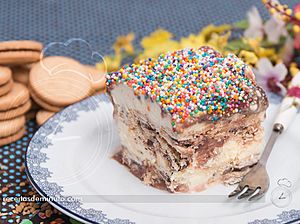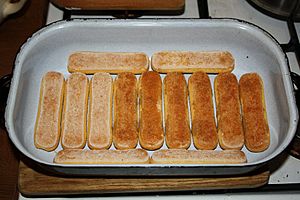Pavê facts for kids
 |
|
| Course | Dessert |
|---|---|
| Place of origin | Brazil |
| Invented | 1960s |
| Cooking time | 4 hours to 6 hours |
| Serving temperature | Cold |
| Main ingredients | Condensed milk, ladyfingers or a Marie biscuit-equivalent (corn starch biscuit, or "biscoito de maisena") |
| Similar dishes | Tiramisu |
Pavê is a super yummy Brazilian dessert. It's made with layers of biscuits and a creamy sauce. Imagine a delicious, no-bake cake! It's often served cold, which makes it a perfect treat on a warm day. Pavê is a bit like another famous dessert called tiramisu.
To make pavê, you usually heat up condensed milk and regular milk. You stir this mix until it becomes thick and creamy. Then, you dip biscuits, like ladyfingers or corn starch biscuits, into milk. These soaked biscuits are then placed in a dish, alternating with layers of the creamy mixture. You can make pavê in many different flavors! Some popular choices include chocolate, dulce de leche (a sweet caramel-like spread), peanut, or fruits like strawberries, pineapples, lemons, and peaches.
What Does "Pavê" Mean?
The word pavê comes from the French word pavé. This word means "cobblestone pavement." People think this name was chosen because of how the biscuit layers are neatly placed, looking a bit like a paved path.
The Story of Pavê
No one is completely sure when pavê was first made. But we do know it's an old recipe! It was created before the tiramisu, which came about in the late 1960s. Recipes for pavê have been found as early as 1937. Even older Brazilian recipes from 1917 describe similar layered desserts with soaked ladyfingers and cream. Back then, they were called "pudding" or just "cream," not "pavê."
In the 1970s, a version of pavê made with peanuts became very popular.
There's a common pun (a funny play on words) about pavê in Brazil. It's often called an "uncle joke" because it's a bit silly! The joke is "é pavê ou pacomê?" This sounds like "is it to look at, or to eat?" but also "is it pavê, or to eat?" It's a fun way to tease someone before you dig into the delicious dessert!
Gallery
-
Dulce de leche pavê
-
Ovomaltine pavê
-
Chocolate pavê
See also
 In Spanish: Pavê para niños
In Spanish: Pavê para niños





